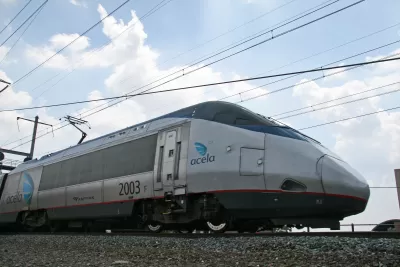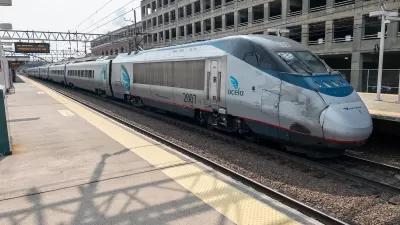Changes to boarding platforms and a switch to electric trains could improve U.S. passenger rail service without the added cost of high-speed rail.

A new report by the NYU Marron Institute’s Transit Costs Project by researcher Nolan Hicks suggests a “suite of targeted improvements” dubbed the “momentum” framework that could speed up passenger rail service in the United States by up to 30 percent — without high-speed rail.
As Benjamin Schneider explains in Bloomberg CityLab, “Hicks’ Momentum approach achieves its time savings not so much from increasing top speeds, but from reducing the “dead time” trains spend idling at stops and getting back up to speed again.” According to Hicks, U.S. trains spend a lot of time at stops due to low boarding platforms that extend boarding time for passengers and diesel locomotives that take longer to start up and get up to speed.
“The first intervention Hicks recommends is high-level boarding platforms. This ADA-accessible design allows passengers to walk or roll aboard without alighting any stairs. It also enables a train car design with wider doors, so more people can get on and off more quickly.” More importantly, electrified trains would accelerate at twice the rate of diesel locomotives, letting trains travel at maximum speed for more of the trip.
“In effect, Hicks is calling for a national rail network built up to the standards of the Northeast Corridor — not a world-class high-speed rail line, but a popular, profitable route that dominates the travel market in its region.” These upgrades could be more attainable for U.S. rail markets, but obstacles such as shared tracks with freight lines and NIMBY resistance to electrical wires and infrastructure remain.
FULL STORY: The Secret Formula for Faster Trains

Study: Maui’s Plan to Convert Vacation Rentals to Long-Term Housing Could Cause Nearly $1 Billion Economic Loss
The plan would reduce visitor accommodation by 25,% resulting in 1,900 jobs lost.

North Texas Transit Leaders Tout Benefits of TOD for Growing Region
At a summit focused on transit-oriented development, policymakers discussed how North Texas’ expanded light rail system can serve as a tool for economic growth.

Why Should We Subsidize Public Transportation?
Many public transit agencies face financial stress due to rising costs, declining fare revenue, and declining subsidies. Transit advocates must provide a strong business case for increasing public transit funding.

How to Make US Trains Faster
Changes to boarding platforms and a switch to electric trains could improve U.S. passenger rail service without the added cost of high-speed rail.

Columbia’s Revitalized ‘Loop’ Is a Hub for Local Entrepreneurs
A focus on small businesses is helping a commercial corridor in Columbia, Missouri thrive.

Invasive Insect Threatens Minnesota’s Ash Forests
The Emerald Ash Borer is a rapidly spreading invasive pest threatening Minnesota’s ash trees, and homeowners are encouraged to plant diverse replacement species, avoid moving ash firewood, and monitor for signs of infestation.
Urban Design for Planners 1: Software Tools
This six-course series explores essential urban design concepts using open source software and equips planners with the tools they need to participate fully in the urban design process.
Planning for Universal Design
Learn the tools for implementing Universal Design in planning regulations.
City of Santa Clarita
Ascent Environmental
Institute for Housing and Urban Development Studies (IHS)
City of Grandview
Harvard GSD Executive Education
Toledo-Lucas County Plan Commissions
Salt Lake City
NYU Wagner Graduate School of Public Service





























